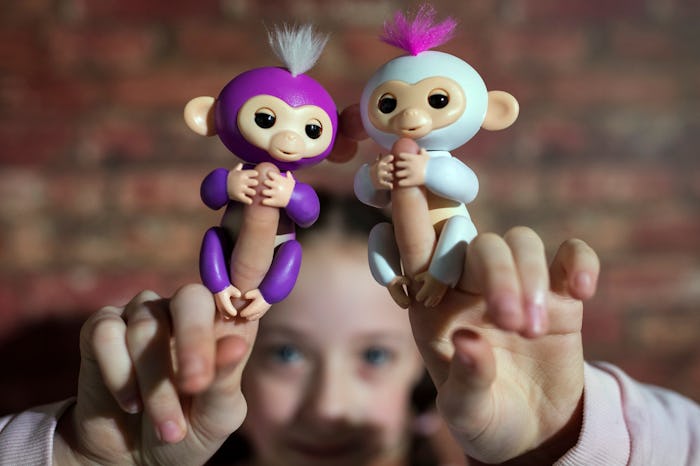Life

Turns Out, There's A Biological Reason Why Fingerlings Are *So* Popular With Kids
What possesses millions of children to ardently desire the same impossible-to-find gizmo at the exact same time? Science may never know exactly what childhood emotional response sends parents scurrying to the Toys "R" Us 40 miles from home, but there's no doubt that when toy mania strikes, it strikes kids hard. And this year? It's Fingerlings. But why are Fingerlings so popular with kids? Actually, this season's must-have gift has a lot going for it, and points to children's universal need to love and feel loved in return (preferrably by a small, adorable animal).
If you haven't heard, Fingerlings are robot grips that doze, chatter, snore, fart, and make smooching sounds at a touch. The super-reactive puppet creature on the just-right side of the uncanny valley is the brainchild of Sydney Wiseman, of the Canadian toy company Wowee. According to The New York Times, Wiseman challenged an engineer at her company to create a robotic figurine in the image of a pygmy marmoset. Later, Walmart executive Anne Marie Kehoe told the Times that she knew the Fingerling would fly off the shelves because of the emotional connection it inspires.
Sure, the toy can't actually love you, but it performs a reasonable facsimile. That, in turn, provokes a fierce answering love in kids, who already have a tendency to anthropomorphize, or attribute human feeling, to creatures with person-like features, according to Psychology Today.
It's a bit frightening to think that the very core of our humanity can be triggered by a microchip wrapped in plastic, but such is life. From 1934's Shirley Temple doll to 1998's Furby, to 2009's Zhu Zhu Pet (the breakout toys of holidays past, published at NBC News, make fascinating reading), chubby, wide-eyed holiday hits are generally cute enough to be delectable, and kids always want to care for something smaller than they are. If that small thing so much as suggests that it returns their affection — well, you might have a blockbuster gadget on your hands.
According to Laurie L. Dove writing at How Stuff Works, people's powerful reaction to anything that makes them say aww is one of humanity's many survival strategies. "Our fondness for cuteness makes us more liable to interact with, care for, and defend babies," she wrote, going on to explain that when it comes to cuteness, species doesn't matter: a pair of big eyes and an oversized head will get us every time.
Even objects can inspire the cuteness response. All they need is a bit of kinderschema — or traits that human beings are hardwired to find cute, reported National Geographic. As Dove explained, the schema behind kinderschema is found in human infants. After all, babies have to be extraordinarily charming for people to dedicate so much time and effort towards keeping them fed, clothed, and surrounded by Fingerlings.
On the adorability spectrum, I think it's fair to say that Wiseman's Fingerling is firing on all cylinders. However, lots of toys on the shelf are plenty cuddle-worthy, and what makes one doe-eyed thingamabob more popular than another may have more to do with the dismal science than the science of cute.
In its feature-length article on 5-inch monkey-bots, The New York Times pointed to the allure of scarcity — the toy everyone wants, but few can find — as a driving factor in a product's popularity. Add a savvy viral marketing campaign to the mix, and you've got a recipe for playground madness. This year, the Fingerling will doubtless bring joy and grief, whimsy and thrills, relief and disappointment into the lives of many. If you want to ride the emotional rollercoaster this holiday season, it's coming — or not — to a toy store near you.
Check out Romper's new video series, Romper's Doula Diaries:
Watch full episodes of Romper's Doula Diaries on Facebook Watch.